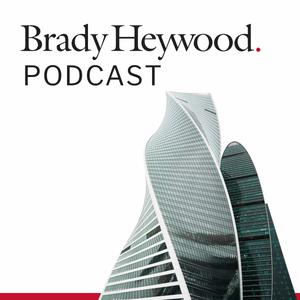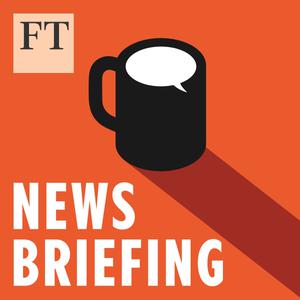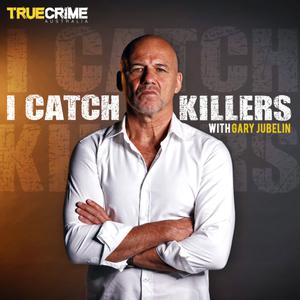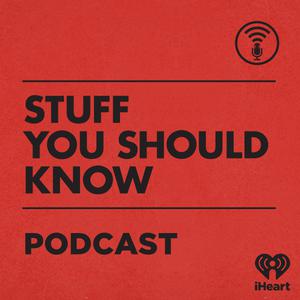
Brady Heywood Podcast
Sean Brady
A show about engineering failures and disasters. We examine the technical, human and organisational causes of failure, and explore why our decision-making is not nearly as rational as we’d like to think.
- 25 minutes 19 secondsIntroducing 'Simplifying Complexity'
As you can tell by the title of this episode this isn’t a normal episode of The Brady Heywood Podcast. In today’s episode we introduce you to a new show that we’ve been working on called Simplifying Complexity, a podcast all about complexity science.
Simplifying Complexity is all about understanding the underlying principles that govern how systems work; systems as diverse as economies, ecologies, cities and countries. In each episode, we'll meet with the experts, and learn everything from how economies can go boom or bust, to how the Medicis wielded power in Venice in the 1400s, and why large animals live longer than small animals. And above all, we'll learn about the principles that tie all of these things together.
In the Brady Heywood Podcast, you learnt how things failed, from a technical standpoint, and an organisational standpoint. Simplifying Complexity takes us one step further, to understand how systems work, and just as importantly, how they fail. If you're interested, we've included a teaser of episode one of Simplifying Complexity, where we're joined by David Krakauer from the Santa Fe Institute, who's going to introduce us to the basics and the history of complexity science.
Connect:
- Simplifying Complexity on Apple Podcasts
- Simplifying Complexity on Spotify
- Simplifying Complexity on Twitter
- Sean Brady on Twitter
- Sean Brady on LinkedIn
- Brady Heywood website
This show is produced in collaboration with Wavelength Creative. Visit wavelengthcreative.com for more information.21 November 2022, 1:01 pm - 32 minutes 31 secondsMiami Bridge Failure - Part 3
In today's episode, we bring to a close our three-part series on the collapse of a pedestrian bridge in Miami, Florida, in 2018.
In part one, you heard about the cracks in the bridge and how nothing was done about them. And in part two, you heard about the serious errors that were made in the bridge's design.
In this episode, we take a deep dive into two unanswered questions from this failure: just why did everyone ignore the cracks in the bridge; and why did a rigorous checking process not identify the errors in the bridge's design?
This show is produced in collaboration with Wavelength Creative. Visit wavelengthcreative.com for more information.31 August 2021, 2:01 pm - 19 minutes 50 secondsMiami Bridge Failure - Part 2
Today's episode is the second of a three-part series on the 2018 collapse of the International University Pedestrian Bridge in Miami, Florida.
In our last episode, you heard how a pedestrian bridge under construction at the Florida International University collapsed in 2018 and killed six people. While many things came together to cause the collapse of this structure, the National Transportation Safety Board (NTSB) identified some serious errors in the design of the bridge.
In this episode, we take a deep dive into these serious design errors as we attempt to understand why this tragedy occurred.
Resources and links:
This show is produced in collaboration with Wavelength Creative. Visit wavelengthcreative.com for more information.31 July 2021, 2:01 pm - 25 minutes 30 secondsMiami Bridge Failure - Part 1
Today's episode is the first of a three-part series about the 2018 collapse of the Florida International University pedestrian bridge in Miami, Florida.
In this part, you'll hear how the signals which could have prevented the collapse of the bridge were ignored, leading to the deaths of six people.
You'll also hear how the checks and balances put in place to identify these bad decisions failed. And how this bridge gave warning sign after warning sign that something was wrong, but the parties involved did little to act.
The more you hear about what happened, the harder you'll find it to understand why it happened.
This show is produced in collaboration with Wavelength Creative. Visit wavelengthcreative.com for more information.30 June 2021, 2:01 pm - 20 minutes 28 secondsThe Brady Review
Today's episode is a little different. It explores 'The Brady Review', a report Brady Heywood undertook on the mining and quarrying industry in Queensland, Australia.
From January 2000 until the end of July 2019, 47 people lost their lives in the mining and quarrying industry in Queensland, Australia. That's an average of 2.4 fatalities per year, or 12 fatalities in any five year period.
What's causing these fatalities? Is it that the mining industry is inherently hazardous? Or is it bad luck or human error?
Resources and links:
This show is produced in collaboration with Wavelength Creative. Visit wavelengthcreative.com for more information.31 May 2021, 2:01 pm - 34 minutes 35 secondsThe Pike River Mine Disaster - Part 3
CONTENT WARNING: This episode contains vivid descriptions of how the miners, who lost their lives in the disaster, died. Listener discretion is advised.
In this final episode of our three-part series on the Pike River Mine disaster, we bring the story to a close.
We examine what took place on the day of the disaster, 19 November, 2010.
Resources and links:
This show is produced in collaboration with Wavelength Creative. Visit wavelengthcreative.com for more information.30 April 2021, 2:01 pm - 26 minutes 33 secondsThe Pike River Mine Disaster - Part 2
In part one of this three-part series on the Pike River mine disaster, you heard what took place in the minutes, hours and days following the methane explosion at the mine.
In this episode, we’ll step back and look at the history of the mine. You’ll hear how the factors that led to the explosion didn't suddenly present themselves on 19 November 2010. Instead, they had been building up over the months and years earlier.
Resources and links:
This show is produced in collaboration with Wavelength Creative. Visit wavelengthcreative.com for more information.31 March 2021, 1:01 pm - 26 minutes 3 secondsThe Pike River Mine Disaster - Part 1
CONTENT WARNING: This episode contains vivid descriptions of the moments that the disaster occurred. Listener discretion is advised.
On the 19th of November 2010, New Zealand experienced one of its worst mining disasters when there was an explosion deep within the Pike River coal mine.
Today’s episode is the first of a three-part series about the disaster. In this part, you’ll hear about the immediate events that initiated the tragedy from the perspective of the people on the ground and in the mine.
This show is produced in collaboration with Wavelength Creative. Visit wavelengthcreative.com for more information.28 February 2021, 1:01 pm - 21 minutes 34 secondsThe 1976 Montreal Olympics Financial Debacle
It's 1970, and the mayor of Montreal, Jean Drapeau, declares that the 1976 Montreal Games will be self-financing.
In his view, these games can no more have a deficit "...than a man can have a baby". In fact, he thinks the real problem will be in determining how to spend the surplus. But over the coming years, all this optimism will evaporate, and the games will become a financial disaster.
This project had everything: poor planning, fraudulent practice and corruption. And it shows what happens when architectural and financial free-reign combine with political ambition and immovable deadlines.
This show is produced in collaboration with Wavelength Creative. Visit wavelengthcreative.com for more information.31 January 2021, 1:01 pm - 20 minutes 43 secondsThe I-90 Tunnel Collapse
In this episode, we head to Boston.
The 'Big Dig' was a road and tunnel construction project designed to solve Boston's congestion problems. With the final project cost exceeding $14 billion USD, this megaproject took 20 years to complete. It involved constructing 25 km of highway lanes, 8 km of tunnel, 16 interchanges and 200 bridges.
But on the 10th of July 2006, at 11:01 pm, a section of the I-90 tunnel collapsed unexpectedly, with tragic results.
So what happened? Why did it take six years to collapse? And how could one of the most costly and complex public infrastructure projects ever undertaken in the US have failed so catastrophically?
This episode follows the National Transportation Safety Board as they answer these questions, and shares insights into how such an investigation is conducted.
This show is produced in collaboration with Wavelength Creative. Visit wavelengthcreative.com for more information.31 December 2020, 1:01 pm - 5 minutes 55 secondsIntroducing 'Saving Apollo 13'
In this short podcast we discuss the re-release of our Apollo 13 Series as Saving Apollo 13. We also talk about the subject of the next more 'traditional' Brady Heywood Podcast Episode.
Saving Apollo 13 is available on iTunes via the link below or by searching 'Saving Apollo 13' wherever you find good podcasts:
Apple Podcasts: Saving Apollo 13 👨🚀
Follow the show on social media:
Twitter: @SavingApollo_13
Instagram: savingapollo13
Facebook: @savingapollo13
Contact Wavelength Creative: https://wavelengthcreative.com/
This show is produced in collaboration with Wavelength Creative. Visit wavelengthcreative.com for more information.13 April 2020, 9:53 am - More Episodes? Get the App
Your feedback is valuable to us. Should you encounter any bugs, glitches, lack of functionality or other problems, please email us on [email protected] or join Moon.FM Telegram Group where you can talk directly to the dev team who are happy to answer any queries.
 FT News Briefing
FT News Briefing
 I Catch Killers with Gary Jubelin
I Catch Killers with Gary Jubelin
 Real Dictators
Real Dictators
 Simplifying Complexity
Simplifying Complexity
 Stuff You Should Know
Stuff You Should Know